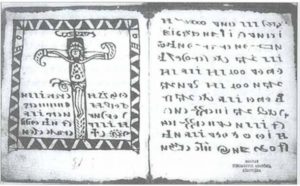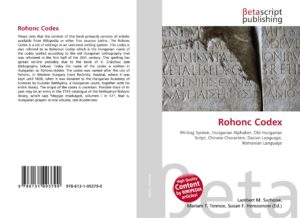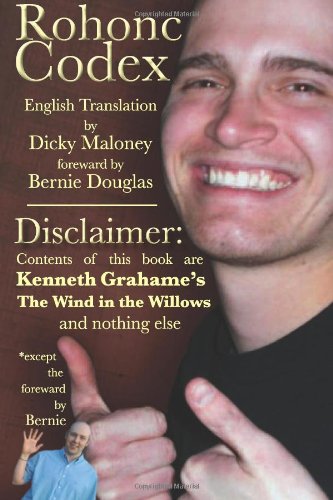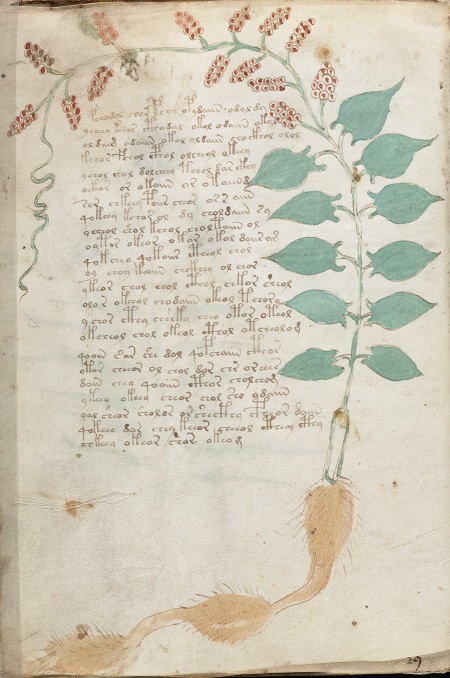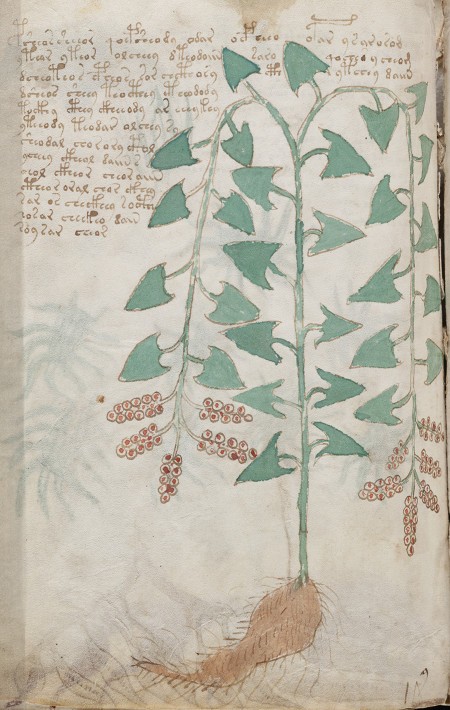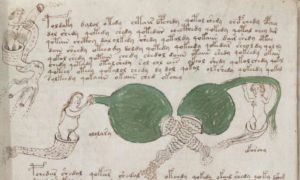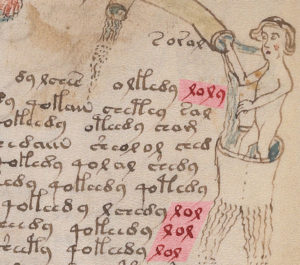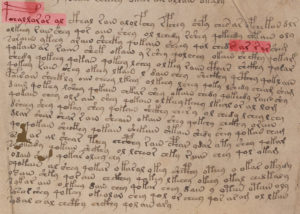Here’s the challenge: explaining what the Voynich Manuscript is usually involves explaining what it isn’t. However, this is so boring that anyone listening would rather disembowel themselves and eat their own entrails. But perhaps Internet memes will be able to achieve the impossible…
Thanks to a nice post on Marco Ponzi’s website, a new block paradigm candidate has presented itself: the short “Liber de Angelis”, the first eleven paragraphs of Cambridge University Library MS Dd.xi.45.
As Marco notes, this was transcribed and translated by Juris G. Lidaka in a chapter in Claire Fanger’s (1998) “Conjuring Spirits: Texts and Traditions of Late Medieval Ritual Magic“. (The full treatise, which is undoubtedly a collection of smaller treatises, is called “Liber de Angelis, Annulis, Karecteribus et Ymaginibus Planetarum”.)
“The Experiment”
Incidentally, this collection has the distinction of having been mentioned by the writer M.R.James in his story “The Experiment: A New Year’s Eve Ghost Story“, first published in the Morning Post, December 31, 1931 (as discussed here). Republished in “A Pleasing Terror”, p.402 refers to “Bishop Moore’s book of recipes”
James’ story concludes:
Bishop Moore’s book of recipes is now in the University Library at Cambridge, marked Dd 11, 45, and on the leaf numbered 144 this is written:
An experiment most ofte proved true, to find out tresure hidden in the ground, theft, manslaughter, or anie other thynge. Go to the grave of a ded man, and three tymes call hym by his nam at the hed of the grave, and say. Thou, N., N., N., I coniure the, I require the, and I charge the, by thi Christendome that thou takest leave of the Lord Raffael and Nares and then askest leave this night to come and tell me trewlie of the tresure that lyith hid in such a place. Then take of the earth of the grave at the dead bodyes hed and knitt it in a lynnen clothe and put itt under thi right eare and sleape theruppon: and wheresoever thou lyest or slepest, that night he will corn and tell thee trewlie in waking or sleping.
However, given that we are not presently concerned with asking the dead for advice about treasure hunting, I leave this merely as an aside / exercise for the reader. 😉
What we are actually concerned with is whether the eleven paragraphs of the Liber de Angelis might somehow be the plaintext of a section of the Voynich Manuscript: so, without any further ado, here they are (as transcribed by Lidaka)…
Liber de Angelis
[1] Signum admirabile experimentorum dixit Messayaac & incipit cum adiuncto Altissimi & est mirabile signum & ualde admirandum in quo sunt secreta Altissimi. Per illud autem ludei operabantur, Caldei, Egipcij, & prudentes Babilonici. Cum igitur operare uolueris, fiat annulus Solis, ex auro fiat, in quo scribantur carecter & nomen angeli solis. & hoc annulus habeatur in omni sacrificio super minore digito sinister manus. Cartam itaque cum mente curiose & studiose custodire in loco mundissimo, & inuolue in rubeo serico.
[2] & hec sunt opera annulus Solis. Cum itaque secundum annulum Solis die dominice ieiunes usque ad noctem, nocte autem facies sacrificium de quada aue non domestica prope litus aque decurrentis, & cum eiusdem auis sanguine scribe carecter & nomen angeli Solis in carta uirginea, & hanc tecum porta. Et cum uolueris transire de vna terra in alteram, depinge in terra carecter Solis & nomen angeli eius, & statim veniet equus niger qui portabit te vbicumque uolueris. Tene tamen cartam in manu dextera & annulum in manu sinistra.
[3] Sicus prius, habeas carecter & nomen angeli eius & scribantur in annulo, & ieiunes in die Lune quo fit annulus Lune, sicud fecisti in annulo Solis, in quo si operare uolueris continuo, sacrificabis anguillam flumalem, cuius sanguine scribe carecter Lune & nomen angeli eius in pelle tue, & inuolue in pelle anguille & reserua vt cum volueris ut appareat flumen uel arbor cum fructu, scribe in terra nomen angeli & nomen fructus, & uoca angelum carta aperta, & apparebit, Si uis ut non appareat, claude cartam.
[4] De annulo Martis. Fiat sacrificium de aue rapaci intra domum ad ignem, et scribe cum eiusdem sanguine in pelle eiusdem nomen angeli & carecteris. Et cum uolueris ut appareant milites armati uel castella uel lubricus ludus, uel ut vincas in prelio, fac caracterem & nomen angeli in terra & appari cartam & apparebit & faciet que preceperis, & cum clauditur carta recedet & cessabit.
[5] Totum fac ut de alijs, sacrificium fiat de uulpe uel de cato in loco deserto, scribe careterem et nomen angeli in fronte – vinces in omni placito. Tene cartam in manu.
[6] Fac sacrificium de gallo, karetter & nomen angeli scribe in pelle, intelligi, in quo inuoluas denarium, & qociens ipsum donaueris reuertetur.
[7] Fac sacrificium de columba alba viuente, carecterem & nomen angeli eius scribe in pelle leporis, quod si mulieri ostenderis sequentur te uelociter.
[8] Totum ut supra. [Damage to leaf has left a small section unreadable here.] Sacrificium de capra inter vepres, carecterem & nomen angeli scribe in percameno veteri. Cum uolueris inter duos odium mittere, eorum nomina in percameno, codem carecterem & nomen angeli in pelle capre, ut predicatur. Cum uolueris aliquem intoxicare, in eius potu intinge annulum Saturni: cum idem potauerit intoxicabitur.
[9] Nunc de generalibus mandatis restat docere. Annulus Solis in omni sacrificio habeatur, & annulus Febe, in quo nomen angeli ipsius; Febe tam in memoria habeatur quam in opera. & fiat sacrificium in circulo infundali, prius scriptus carecter, & in medio magister dicat: ‘Oya, sacrificium tue laudis suscipe’, proiciens carnes extra circulum. In qualibet autem operacione, nomen angeli inuocetur & annulus in digito habeatur. Carte uero mundissime reseruentur, nec in noctis tenebris aperiantur nisi operis necessario ingrauerit.
[10] Nunc de annulis. Annulus Solis ad equum & fiet de auro. Annulus Lune ex argento ad fluuium. Annulus Martis ex ere ad uictoriam in bello. Annulus Mercurij ex cupro ad scienciam. Annulus Iouis ex electro ad denarium. Annulus Veneris ex plumbo ad amorem. Annulus Saturni ex ferre ad odium. Annulus Capitis Draconis ex calibe ad toxicandum.
[11] Hox signum mirabile est experimentum magistri Messayaac de secretis spirituum planetis, secundum mencionem, & sumitur sic. Omitto nomina angelorum cum carecteribus suis (que incipiunt sic: Storax, Abamecta, Paymon, cum ceteris) propter certam causam hic scribenda.
It’s Not by Osbern Bokenham
Though it was once thought to have been written down by Augustinian poet-monk Osbern Bokenham, Lidaka dismisses this quickly. But as a nice point of history, Osbern Bokenham did once conceal his identity in the chapter initial letters (much as in the Hypnerotomachia Poliphili) as discussed here:
On 1st May 1456 he wrote Dialogue betwixt a secular asking and a Frere (friar) answering at the grave of Dame Joan of Acre. This is a very important source for the history of Clare Priory. This manuscript, which still exists, is written in both Latin and English, and richly decorated on parchment. Another of his works was called Mappula Anglicae, which covered the rhymed lives of English saints such as Cedde, Felix and Oswald.
It contained seventeen chapters, and was anonymous, except that Bokenham stated that, if taken in sequence, the first letter in each chapter spelt out the name of the author. It reads OSBERNUS BOKEN_HAM. Chapter 15 is missing.
[Yes, it does indeed look from that as though it was actually Chapter 14 that was missing, but let’s not quibble.]
It’s Actually by William Bokenham
Though the surname of the Liber de Angelis writer was clearly Bokenham, Lidaka points out that the author’s first name was William, and that he was copying various small treatises, not composing them. Moreover, given that two works dealing with urine (that most multispectral of medieval medical staples) by a William Bokenham are in Wellcome MS 408, and that in them he claimed to be “a doctor with a degree from Bologna” as well as “a monk at Norwich Holy Trinity (or St Giles)”, we would seem to have our copyist locked down quite solidly.
From internal evidence (the ‘Oya’ in paragraph #9), Lidaka suggests that the Liber de Angelis version being copied may well have been derived from an earlier French language version: and separately that the ultimate source of at least some of the tracts could perhaps be Arabic. In which case, it might be a good idea to get acquainted with David Pingree’s “The Diffusion of Arabic Magical Texts in Western Europe” (Ladaka’s note #14). [Jim Reeds is also mentioned in note #20, crypto-history fans.]
Personally, I’m also a little suspicious of the “karetter” in paragraph #6 as being a possible linguistic tell.
And Now We’ve Done All That…
…I’ll compare this with the Voynich Manuscript’s planets in a follow-on post, 1300 words is quite enough for the moment. 🙂
Following on from the Oxford Mail’s brief article I covered here a few days ago, here’s yer akshual Wagamama press release, courtesy of those upstart challenger funsters at Talker Tailor Trouble Maker who put the competition together for their Japanese/Asian food-selling clients:
Mark Knowles has also sent me through A4 scans of the A3-sized entry form / paper placemat direct from Oxford (which was very kind of him): but given that we now have the proper press release to refer to (and hence know for sure that the string of numbers in the Oxford Mail was correct), and also know that Rene Z has figured the answer out, I think anyone wanting to enter will just have to drop by, fill in an entry form, and drop it in the box all on their own.
“Give Us A Clue” *sigh*
People keep asking me for clues to the mathematical bit: however, all I can reasonably say for that is that you should tighten your girdle, prime your weapons, and keep on marching through, you’ll get there in the end. It’s a fact! Or maybe not. 🙂
As for the anagram stage, I think that Wagamama may have been stretching the notion of what counts as “topical” a little further than you may at first think, so perhaps try to expand your view somewhat. 😉
Good luck! And if you do happen to win the £500 gift voucher, don’t forget to invite me round for some edamame beans. 😉
According to this rehash of a press release hard-hitting article from this week’s Oxford Mail that Cipher Mysteries reader ‘LV’ kindly sent me:
A NEWLY refurbished Oxford restaurant is offering brainy punters six months free food – if they can crack an ‘impossible code’.
Wagamama in George Street has appealed for people to take on a complex equation to be in with a chance of bagging a voucher worth £500.
The competition is being launched today, Albert Einstein’s birthday, and is open until 10pm on March 21.
It’s just a little bit of a shame that Stephen Hawking happened to expire on the very same day, otherwise I’m sure all the papers would be talking about is Wagamama’s clever cipher. Oh, and as you’ll see, it’s clearly not a “complex equation” in any useful sense of the word, so please try not to get too taken in by the allusions to the wonders of maths in what follows.
Set by an Oxford University mathematician, the puzzle is as follows:
Each number below encodes a letter of the alphabet. When you’ve worked out the letters, you’ll need to unscramble them to make three topical words.
330 33 2 105 55 10 2 2 70 2 105 14 42 11 2 10 154 2 11 70 30 2 70
To enter visit Wagamama’s Oxford branch and pick up a form.
Essentially, the way this is supposed to work is that once the deadline passes, the puzzle-setter stops snickering into the back of his/her Oxonian hand long enough to reveal the trick behind the letter-to-number mapping, at which point we all kick ourselves for not seeing the trick. Arguably, this is more steganography than cryptography, but it’s a bit of fun nonetheless, right? Better than turn-of-the-century lovers’ pigpen postcards, wouldn’t you say, eh?
Some Quick Thoughts
Firstly… as a starting point, the unique numbers and their instance repetitions in the cryptogram are:
10 10
105 105
11 11
14
154
2 2 2 2 2 2 2
30
33
330
42
55
70 70 70
Secondly, it’s seems fairly obvious that (as I flagged above) this probably isn’t some mathematical equation-based thing, but rather some trick that maps numbers onto the letters of the alphabet (for you to then anagrammify). Similar ciphers I’ve seen in the past have converted Morse Code letters into numbers (e.g. SOS = … — … = 3 8 3, etc i.e. where 12345 = ./../…/…./….. and 67890 = -/–/—/—-/—–), or have converted a Braille pattern into a binary number, or have yielded a grid position: but there’s surely tons of room for ACA-style fans to devise new letter-to-number puzzle mappings. For instance, you could map AEIOUY = 123456, and then add a digit counting forward from that vowel, e.g. ABCDEF = 10 11 12 13 20 21 (etc), and so forth.
What is a little unusual about Wagamama’s particular numbers is that there are no sixes, eights, or nines, as well as the way so many end in 0: while the cluster of 30 / 33 / 330 also seems to offer some kind of blatantly obvious clue (in retrospect, next week some time) as to the nature of the system, not too dissimilar to the clue (supposedly) hidden in the microdot in the ‘i’ in Arnold Rimmer’s swimming certificate.
Thirdly, the seven instances of ‘2’ would normally make it highly likely to be E or T (the highest frequency letters in English): but given that “EINSTEIN” seems a bit too obvious, perhaps “WAGAMAMA” is one of the “three topical words”, making ‘2’ instead ‘A’. This is normally the kind of half-hearted joke that tends to amuse PR flacks sitting in wine bars (and what are the odds this was 1855 Oxford?), but you probably guessed that already: it’s not as if they would have used a properly topical word like “NOVICHOK”, right?
Finally, just about the only Cipher Mysteries reader in Oxford able to pick up a form is Mark Knowles: I just hope he likes cracking puzzles and Japanese-inspired Asian-esque fusion food. 😉
Update: well, I’ve now solved the letter-to-number correspondence stage, which in fact is mathematical, though (as I predicted above) not really in anything like a “complex equation” sense. (Does anyone want a hint? Unlike President Snowball, I’m not really into spoilers, and you’ll enjoy it more if you work it out for yourself.) I’ve also worked out one of the three words (which, again, was as I predicted above: WAGAMAMA), so all I have to do is work out the other two “topical words”, neither of which is EINSTEIN, unless they cocked the puzzle up… 😉
Until such time as the sun burns out and/or the Kardashians are no longer celebrities, the Internet will continue to be littered by clickbait gosh-wow pages claiming to list the top [insert number here] cipher mysteries. And of the unsolved ciphers these typically include, probably the least known is the Rohonc Codex.
And so I decided a few days ago to go looking for a definitive book on the Rohonc Codex. After all the years the Rohonc Codex has spent under the world wide web’s spotlight, one such book must surely have come out by now, right?
Well… wrong, actually. But regardless, I thought I ought to flag two of the books I did find, purely as some kind of blogtastic public service…
The second worst Rohonc Codex book ever
In this digital printing age, it turns out that there are a number of groups of people who rip articles out of Wikipedia (often by the hundred or even thousand) and market them as ebooks and/or POD (“print on demand” books). In the case of BetaScript Publishing, their Rohonc Codex book is entitled (unsurprisingly) “Rohonc Codex”; is 120 pages long (though my guess is that most of those are generic filler); is one of some 5000+ titles churned out by the company; and is priced at a splutter-worthy 28.99 euros.
In the absence of any clear scenario where parasitic non-books like this are genuinely a good idea for someone somewhere (and not just a scam), all I can do is advise you that rubbish this bad really does exist, in the hope that you don’t buy it.
Besides, if you do have money burning a hole in your pocket that you’re desperate almost beyond measure to spend on something utterly pointless and yet marginally Rohonc Codex-related, there is another book out there that arguably offers less value than this…
The worst Rohonc Codex book ever
As you doubtless know, digital publishing platforms have allowed a vast number of completely baseless and zero-merit theories about cipher mysteries to emerge into the sunlight of Amazon.com’s virtual repository. All the same, I must confess that even I wasn’t quite ready for the 156-page “Rohonc Codex: English Translation Paperback” (2011), courtesy of Linnaeus Hoffmann Publishing and “Mr Dicky Maloney (Author), Mr Kenneth Grahame (Author), Mr Bernie Douglas (Introduction)”. Yes, the very same “Mr Kenneth Grahame” who died in 1932.
For it turns out that:
The Rohonc Codex is a Twelfth Century Hungarian text, written in a language, that until this very day, has not been translated by anyone else. Not a single word. And then Dicky Maloney painstakingly translated this text, word for word. As it turns out, by pure coincidence, it is Kenneth Grahame’s The Wind in the Willows, word for word.
And here’s the cover, which is in the same general vein:
Now OK, it’s obviously just a joke: and Linnaeus Hoffman Publishing’s other book (also from 2011) was “The Stickwick Staplers”, a marginally satirical opus from which you can read a small chunk (which probably is as much as is safe for anyone not wearing a hazmat suit and ten-layer blindfold to digest) courtesy of Amazon’s Look Inside (Before Sticking Your Fingers Down Your Throat) feature. I’d normally say “Enjoy!” here, but on this occasion I’m not sure I can bring myself to. 🙁
However, I was kind of impressed by the way that (the now-defunct) www.linnaeushoffman.com website had only a single entry in the Wayback Machine (from January 2013), a snapshot which contained not even a single webpage: this would seem to have been a successful attempt to construct an entirely unseen corner of the Internet.
It is of course conceivable that “Rohonc Codex: English Translation Paperback” will turn out to be a book industry ‘sleeper’, an unbelievably splendiferous secret hit so beloved by Those Opinion-Makers Who Know (And Indeed Define) What Is Hip And Cool that it has been continuously optioned by every major Hollywood film producer since 2011, whose attempts to bring it to the silver screen have been thwarted solely by the book’s unfilmable brio. But I suspect the odds are somewhat against that scenario. 🙁
Then again, it’s not widely known that Kenneth Grahame’s “The Wind in the Willows” received terrible reviews when it first appeared blinking into the hostile light of day in 1908. It was only unexpected plaudits from US President Theodore Roosevelt that helped make it popular: almost nobody else at the time saw its merits. So who am I to judge a book that I can’t buy or even download (and which I expect was never actually printed)?
If you like cold case documentaries with only a mere frisson of cryptography, “Cold Case Files 1: The Zodiac” (which was recently uploaded to the TagTele site) could well be for you. While it’s an oldie (first released way back in 2003), it doesn’t try to impose any theories, but concentrates on interviewing people who were actually there… well, up to timecode 25:40, anyway, when it suddenly goes into ‘Arthur Leigh Allen = prime suspect’ mode (but then constantly bangs on about how he almost certainly wasn’t the Zodiac). Which is nice.
video since removed from TagTele site
What I wasn’t expecting was that – quite the opposite from what you might think from 2017’s documentary crop on the History Channel (which is an anagram, not many people know, of Clannish Theory, Shithole Cranny, and Horny Chatlines) – the police had actually worked through lots of the Zodiac DNA evidence by 2002. In the video, the specifically DNA-based angle (which starts at about timecode 33:25) shows that when DNA from Arthur Leigh Allen’s preserved brain was compared with the best reference samples derived from Zodiac primary evidence, it was enough to exclude him from being the Zodiac Killer.
Moreover, the documentary also discussed “writer’s palm” (from about 36:50 onwards), which is the imprint left by someone’s palm as they write a document. What it revealed (which I didn’t know) was that the palm prints police forensically recovered from Zodiac letters were good enough to compare with palm prints taken from Arthur Leigh Allen: all of which also proved that he was not the Zodiac Killer.
Of course, while it sounds ever so intriguing that Arthur Leigh Allen had a Zodiac watch, he was actually a scuba diver, and that was basically who Zodiac watches got marketed at. As an aside, I do wonder if the police ever looked at SF scuba clubs of the period: that may have been more of a productive avenue to explore than the American Cryptogram Association. Ah well. :-/
Incidentally, if you want to see a young-looking Tom Voigt, he’s in the documentary from about timecode 40:15, with the voiceover saying that his website gets a million hits per month (back in 2003). Goodness knows how much traffic it must get now, blimey. :-/
I’ve just watched a sort-of-mostly-interesting voynich.ninja interview with Adam Lewis, whose senior thesis at Puget Sound I mentioned here a few days ago.
However, one particular part of his argument (as presented in the interview, at least) made no real sense to me at all: that even though the Voynich offers (Lewis says) a decent-sized corpus of text to work with [in fact, it’s possibly the largest ciphertext from the pre-machine-cipher era], its text style is somehow too ‘samey’ for linguists to find the weak link in (and hence crack).
In fact, we have (at least) two ‘languages’ to work with, better known in Voynich circles as Currier A and Currier B (named after the distinguished US code-breaker Captain Prescott Currier, who first noted them in the 1970s), though it remains an open question as to whether or not they are closer to ‘dialects’ than distinct ‘languages’ per se. Hence I’m not entirely convinced by Lewis’s argument.
Regardless, might there be some subtle thread (whether linguistic, cryptological, or whatever) connecting two different blocks of text that we can trace between the two pages they appear on? Might we be able to find a tentative internal Voynichese text match (be it ever so small) to cast some faint light on both parts, in precisely the way that Adam Lewis asserts that we cannot?
Well… I hope you’ll agree that it’s worth attempting, so let’s give it a go, eh? 🙂
Three Pages, One Plant?
I believe that most Voynich researchers would agree that – very unusually – a single plant seems to appear in three separate places in the manuscript: f17v, f96v, and f99r. Long-suffering Cipher Mysteries readers may also remember that I posted about these pages back in 2013.
Note that identifications of the plant are somewhat nebulous and unsure:
* Dana Scott – wild buckwheat (Ellie Velinska tends to agree with this, or perhaps bryony)
* “biologist from Finland” – – Rumex acetosella? or Smilax aspera (=common smilax) or Smilax excelsa. Or Dioscorea communis / Tamus communis?
* Peter – Tamus communis or Smilax aspera
* MarcoP – Cadamosto’s “vitis nigra” (black vine) commonly “tamo” (“vitis nigra tamo dice lo vulgo”), i.e. Tamus communis
* JKP – suggests many different plant matches
* Kieran Coughlan – Creeping Nightshade (Solanum Dulcamara)
* Edith Sherwood – yam (even though yam is post-Columbus) – and she thinks she can see Leonardo da Vinci’s signature hidden in its hairy roots. As always, make of that what you will.
(Doubtless there are many more to be found, but that’s the point where I lost interest.)
Codicologically: even though f96v and f99r would at first appear to have had a pair of pages inserted between them at some stage (i.e. f97 and f98), they ended up facing each other in the Voynich’s final state. Moreover, f96v is the last page of quire 17, and f99r is the first page of quire 19: my best reading (that I put forward in 2012 in Frascati) is that there was never any such pair of inserted pages, but that instead someone else had previously misnumbered the final two quires (Quire 19 and Quire 20), and that the two extra pages there were added to account for the ‘Quire 18’ that was never actually there. Perhaps none of this is actually important: but I think there’s a good chance that – contrary to their final folio numbering – f96v and f99r have sat facing each other for some time, perhaps even in the original gathering order.
Anyway, comparing the blocks of text reveals something I think is rather unusual, and which may possibly come as a surprise to many who look more at the drawings than at the text: that even though they share the same plant drawing, they really are – when you look a little closer – very different indeed from each other.
f17v
1. pchodol.chor.fchy.opydaiin.odaldy
2. ycheey.keeor.cthodal.okol.odaiin.okal
3. oldaim.odaiin.okal.oldaiin.chockhol.olol
4. kchor.fchol.cphol.olcheol.okeeey
5. ychol.chol.dolcheey.tchol.dar.ckhy
6. ockhor.or.okaiin.or.otaiind
7. sor.chkeey.paiir.cheor.os.s.aiin
8. qokeey.kchar.ol.dy.choldaiin.sy
9. lcheol.shol.kchol.choltaiin.ol
10. oytor.okeor.okar.okol.daiir.am
11. qokchey.qokaiir.ctheol.chol
12. oy.choy.kaiin.chckhey.ol.chor
13. ykeor.chol.chol.cthol.chkor.sheol
14. olor.okeeol.chodaiin.okeol.tchory
15. ychor.cthy.chshky.cheo.otor.oteol
16. okcheol.chol.okeol.cthol.otcheolom
17. qoain.shar.she.dol.qopchaiin.cthor
18. otor.cheeor.ol.chol.dor.chr.oreees
19. dain.chey.qoaiin.cthor.cholchom
20. ykeey.okeey.cheor.chol.sho.odaiin
21. oal.sheor.sholor.orshecthy.cpheor.daiin
22. qokeee.dar.chey.keeor.cheeol.ctheey.cthy
23. chkeey.okeor.shar.okeom
A list of mildly distinctive features of f17v might well include:
* the “ol.olol” repetition on line 3
* the single-leg gallows on line 1 (possibly a Neal Key?) and on line 4. (Might line 4 in fact be the start of a second paragraph?)
* note that the single-leg gallows on line 17 also looks like it might be the top line of a paragraph
* the “qoain” on line 17 (this appears only 7 times in the manuscript) and “qoaiin” on line 19 (this appears only 23 times)
* the “autocopied”-like choldaiin/choltaiin pair on lines 8 and 9
* chol appears 11 times (as itself and within other words)
* chol.chol (line 13) appears 39 times in A pages but only a single time in B pages
f96v
1. psheossheeor.qoepsheody.odar.ocpheeo.opar.ysarorom
2. yteor.yteor.olcheey.dteodaiin.sary.qoches.ycheom
3. dcheoteos.cpheos.sor.chcthory.cth.ytchey.daiin
4. dsheor.sheey.teocthy.ctheodody
5. tockhy.cthey.ckheeody.ar.cheykey
6. yteeody.teodar.olchey.sy
7. sheodal.chorory.cthol
8. ycheey.ckheal.daiin.s
9. oeol.ckheor.cheor.aiin
10. ctheor.oral.chor.ckhey
11. sar.os.checkhey.socthh
12. sosar.cheekeo.dain
13. soy.sar.cheor
Here:
* the four single-leg gallows (p) on line 1 could very easily be flagging Neal Keys in some way (e.g. [p] + “sheossheeor.qoe” + [p])
* there are only three instances of “yteor” in the whole manuscript, and line 2 has two side by side
* the way that “s” is used as the first character of lines 11-13 gives the appearance of being filler in some way (e.g. a null)
* there’s also an autocopyist-style diagonal set of “sar”s on lines 11-13 (sar / sosar / soy.sar) that also looks like filler
* the repetition of ctheodody and ckheeody on lines 4 and 5 makes it look as though ctheodody may have been a miscopying of ctheody
Hence even though the use of ‘language’ superficially appears similar to f17v (Currier-wise), there are very few actual similarities.
f99r, final paragraph
1. tolkeey.ctheey
2. ykeol.okeol.ockhey.chol.cheodal.okeor.olcheem.orar
3. okeeey.keey.keeor.okeey.daiin.okeols.aiin.olaiir.oolsal
4. qokeey.okeey.qokeey.okesy.qokeey.sar.sheseky.or.al
5. yshain.yckhey.octhey.dy.daiin.okor.okeey.shcthy.sh
6. ychor.ols.or.am.airam
Here, “qokeey.okeey.qokeey.okesy.qokeey” on line 4 is exactly the sort of repetitive garbage that reduces attempted linguistic decryptions to mush while simultaneously giving heart to hoax theorists and their CompSci tables.
A vs B, again
We can try categorize these three pages by revisiting Currier’s original notes on A and B,:
(a) Final ‘dy’ is very high in Language ‘B’; almost non-existent in Language ‘A.’
(b) The symbol groups ‘chol’ and ‘chor’ are very high in ‘A’ and often occur repeated; low in ‘B’.
(c) The symbol groups ‘chain’ and ‘chaiin’ rarely occur in ‘B’; medium frequency in ‘A.’
(d) Initial ‘chot’ high in ‘A’; rare in ‘B.’
(e) Initial ‘cth’ very high in ‘A’; very low in ‘B.’
(f) ‘Unattached’ finals scattered throughout Language ‘B’ texts in considerable profusion; generally much less noticeable in Language ‘A.’
Additional observations noted by Rene Zandbergen:
(g) The very frequent character combination ed is almost entirely non-existent in all A-language pages.
(h) The very common character combination qo is almost completely absent in the zodiac pages and the rosettes page, but appears everywhere else.
(i) The common character combination cho does not appear in the biological pages (and the rosettes page), but it does in other B-language pages.
From this, we can say (somewhat uncomfortably) that:
* f17v is a definitely-Currier-A page (it has lots of “chol” and “chor” instances, as well as cth- words)
* f96v is a sort-of-a-Currier-A page
* f99r is a sort-of-a-Currier-B page
And so we get to the awkward situation I highlighted back in 2013, that A vs B is far too simplistic to be a globally useful razor, and that we also don’t yet have a good ‘roadmap’ for how the ‘language’ used in the Voynich Manuscript evolves and changes through its pages. Which is essentially why I think that Adam Lewis is being too reductive when he claims that Voynichese is too samey across its pages to be crackable – the actual situation would seem to be that Voynichese is actually too unsamey for anyone to get a grip on.
But is there a match?
Back in 2013, commenter Šuruppag suggested on my original page that there might possibly be a very short match between all three blocks of text. Specifically (as transcribed above):
* f17v line 5: ychol.chol.dolcheey
* f96v line 2: yteor.yteor.olcheey
* f99r line 3: keey.keeor.okeey
Šuruppag continued:
A nice little sequence that occurs once in each passage. Seems to show similar pattern and characters.
Perhaps this sequence (possibly the name of the plant?) shows us the evolution of the cipher. Feel free to criticize if you don’t think so.
I would add that there’s reasonably good evidence (I flagged this in The Curse of the Voynich in 2006) that “-y” may mark where a longer word has been truncated: and so “keey” on f99r could very easily be a (slightly) truncated version of “keeor”. In which case we might wonder whether “yt” on f96v is enciphering the same underlying letter as “k” on f99r.
Again, in Curse in 2006 I proposed that EVA ok / ot / yk / yt (all of which appear prominently in label-driven sections such as the zodiac pages, e.g. “otolal”) might well be verbose cipher pairs, whereas EVA t / k (i.e. where not immediately preceded by o or y) might well be some kind of transposition cipher where a different letter gets inserted from elsewhere in the text (t and k are basically interchangeable in almost all circumstances). This makes me suspect here that the last word of the phrase on f99r should actually be olkeey rather than okeey, because “ok” would then be a verbose cipher whereas “olk” would be parsed as “ol-k”.
I also wrote in Curse that I thought not only that EVA e / ee / eee / ch shapes were verbosely enciphered vowels, but that their mapping and use seemd to change between A and B pages. So I for one would not be hugely disturbed if it were to be the case that EVA “e-or” in f96v reappears as EVA “ee-or” in f99r.
And finally, I have also proposed that where Voynichese words start with “d-“, this may well turn out to be a signal that a longer word has been split up into two shorter words. (For example, I suspect that daiin daiin sequences encipher groups of Arabic digits that should be joined together.)
Putting all these fragments together, I wonder if perhaps the three lines (if the various miscopyings were corrected, and the f99r -y rectified as -or, and the words reassembled) were originally supposed to be parsed as:
* f17v line 5: ychol..chololcheey – – – or perhaps “ychol.ychololcheey”
* f96v line 2: yteor.yteorolcheey
* f99r line 3: keeor.keeorolkeey
Hence it seems to me that what might well be going on in the f99r line is that three “k”s are being used to stand in for yt / yt / ch respectively, i.e. that the encipherer is using a transposition (i.e. replacement from elsewhere in the text) cipher trick rather than f96v’s verbose cipher trick to encipher the same plaintext word.
But what then of f17v’s text? My best current guess is that this version may well be closer still to the same small block of plaintext being enciphered on all three pages.
One cipher alphabet, multiple verbose ciphers?
More awkwardly than all of the above, the above seems to suggest that chol in the first page be the same as eor in the second page and eeor in the third page: that is, that even though the Voynichese letters are the same across different pages, the arrangement of verbose ciphers using those covertext letters may well be changing. Is our inability to read Voynichese then largely a consequence of multiple verbose cipher arrangements having been used?
When this kind of Voynichese discussion comes up, I often think back to my late (and intensely argumentative) friend Glen Claston. When he was building up his Voynichese transcription, he often noticed (as he mentioned to me a couple of times) that the patterns and styles of words would “shift” every few lines or paragraphs, as though it internally changed into a different gear or mode. He was never able to quantify this shift more precisely (even though he was a keener observer than almost everyone), but perhaps there lurks at the heart of Voynichese some kind of verbose cipher modality – not enough to disrupt the overall “look” (i.e. of the covertext), but more than enough to throw the decryptor hounds off the crypto-scent.
That is, perhaps what these three lines is trying to tell us is that we should be looking not for a single global verbose cipher key (as might be suggested by the way that the covertext consistently uses a relatively small set of cipher glyphs), but for a number of different (and rather more localized) verbose cipher keys. Voynichese’s covertext may be formed from a single set of glyphs across all its pages, but might the complexity around the different blur of Currier ‘languages’ actually be telling us that there are multiple encryption schemes in use?
If that is correct (to even some degree), what would we need to do to get under Voynichese’s skin? I’ve often spoken of the need to try to map Currier A usage to Currier B usage (to try to identify equivalent sequences in the two parts), but perhaps this is only 5% of the larger challenge, and moroever a step that makes no sense until the verbose ciphers have been even partially mapped – for it could very well be that a part of a single page might well need to be remapped to a different part of the same page in order to be able to parse it, let alone read it. Perhaps the first step should be to try to find examples of Voynich Manuscript pages that exhibit Clastonian multimodality (i.e. where there is an apparent shift in the system within the page), and see if we can quantify how the changes in behaviour work in practice, just so that we can even try to parse what is going on.
Tricky, though. 🙁
If a device could be constructed to reclaim the effort – by which I mean purely physical effort – put into constructing Voynich decryption non-theories, I reckon it could probably power Grimsby (population “88,243 in 2011”, according to Wikipedia) indefinitely. Add in the additional effort expended to construct ad hominems against people who are deemed to be opponents of said non-theories, and you could probably power Cleethorpes (population “nearly 40,000 in 2011”) too.
Sadly, such advanced energy-harvesting technology remains beyond even Silicon Valley’s greatest egos minds, so for now the best we can do is to throw some more theories onto the fire to keep us Northern Hemisphereans warm through the (oddly late) winter chill.
Ata Team Alberta
A four-year-long “family project” (the Ardiç family, i.e. Ahmet Ardiç, Alp Erkan Ardiç, Ozan Ardiç, etc) calling itself “Ata Team Alberta” (ATA) claims (in a YouTube video) that it “has deciphered and translated over 30% [of] the manuscript”, and has submitted “a formal paper of the philological study […] to an academic journal in John Hopkins University.”
The team claims that Voynichese is nothing more than a kind of “Turkic language”, written in a “poetic” style that often displays “phonemic orthography”: they mention f33 as being particularly “rhythmically matching”. Well… anyone who wants to have a look at what they’ve done can fast-forward to 5:02 in the video, which is where their tricksy character correspondence tables start to appear.
Incidentally, when mildly pressed by the Toronto Metro, Lisa Fagin Davis assessed Ata Team Alberta’s efforts as “one of the few solutions I’ve seen that is consistent, is repeatable, and results in sensical text”. Which is, of course, a somewhat peccable (if perhaps slightly maculate) opinion to be holding.
According to this news report, Ahmet is now flying to Turkey to consult with Old Turkic specialists (presumably because all the young specialists are busy). Perhaps he’ll have more to say when he returns.
Gerone Wright
According to Gerone Wright, “it was almost as if I believed in myself that if I studied this text long enough, I would actually know what it means“. And so here’s Gerone telling everyone in the world (via the magic of YouTube) how the Voynich Manuscript is all chemistry, stem cells, genetics, and stuff: and even how some of Q13’s diagrams illustrate ovaries, fallopian tubes and fibroids (etc). Almost, anyway:
The point of including this video here is not that it casts any obvious light on the Voynich Manuscript, but rather that (a) most broadly similar YouTube Voynich theory videos seem to have been done by confused men sitting on cheap sofas in badly-lit sitting rooms wearing only their tighty whities (and that’s not really something that has ‘shareable’ written all over it), and (b) unlike almost everyone in (a), at least Gerone seems to be vaguely aware that what is powering his particular decryption is not so much cryptologic or historical smarts as intense self-belief. Which alone is a rare insight to be blessed with.
Viktor V. Mykhaylov
After sixteen years of effort (yes, four times as much as those Ata Team Alberta wimps), Viktor Mykhaylov of New York has written a book about his Voynich decryption, entitled: Mystery of Senzar. And once again there’s a freshly-minted 2018-vintage YouTube video:
Sample translation of f1r: “Do you graze a goddess-cow? Where? Is this the former deity of the Sun?” And before long: “Have you born this goddess – Eye?”
Aye, indeed. Mykhaylov describes his decryption as follows:
The Manuscript was written in ancient forgotten Senzar language, like mix of Vedic Sanskrit and Devanagari, which was before them – Proto-language. The Manuscript was written in November-December 1417, in Vilnius, by Metropolitan of Kyiv and All Rus-Ukraine, Lithuania, Zhemaytia, Mlodovlakhia (Moldova), Gregory (Gavryil) Tsamblak (Samvlah), and his monks specially for the Queen of Bavaria and Bohemia Sophia, who was the wife of King Wenceslavs IV. This Manuscript was written because Queen Sophia considered herself a goddess Ra.
Metropolitan Samvlah by order of Grand Duke Vytautas, and King of Poland Jagiello, was the head of the largest delegation (about 300 participants) to the Cathedral in Constants. Among all participants were the ambassadors from Saladin – Ayyubid dynasty – An-Nasir Salah ad-Din Yusuf ibn Ayyub.
All of which may be oddly familiar to those who remember John Stojko (“Letters to God’s eye: The Voynich manuscript for the first time deciphered and translated into English”, 1978), who similarly proposed that Voynichese was some kind of proto-language from Ukraine. (I vaguely recall that Stojko lived and died in New York state as well, but I’m not 100% sure of this.) Incidentally, the “Cathedral in Constants” Mykhaylov is referring to here is actually the Council of Constance (1414-1418).
(And yes, I know that Saladin lived from 1137 to 1193. But let’s not bicker over mere details, OK?)
But then Mykhaylov goes and spoils it somewhat by skiing so far off-piste that nobody else can reach him:
Thanks to reading this Manuscript, I received the key to understanding and explaining the origin of all religions, and their names, that existed and now exist, the origin of all tribes and civilizations, and their names, those that existed and now exist, the origin of all languages that were used and that are used now on Earth. I will display all this information in my books, on which I am now working.
Oh well! 🙁
Given that most Voynich furrows have been heavily overploughed over the last two decades, it has become rare for something novel to pop up on my Voynich radar. On those rare occasions such a thing does happen (e.g. the Sagittarius crossbowman, etc), I do try to use my posts to communicate a sense of enthusiasm and excitement.
And so here’s something that might well prove to be interesting: an “Honors senior thesis presentation” courtesy of Adam Lewis at the University of Puget Sound in Tacoma in Washington, entitled “An Anatomy of Failure: Analysis Attempts to Decode the Voynich Manuscript” – 6pm-7pm on 21st February 2018, at UPS’s Wyatt Hall, Room 109.
Incidentally, here’s a picture of the University of Puget Sound’s mascot “Grizz the Logger” in action:
So… why is it that the floor around the VMs is littered with so many dead bodies, so many foolish theories, indeed so many grotesquely idiotic theories? What is it about the Voynich Manuscript that draws out the airiest and least tethered of speculations from people? It’s certainly a topic I’ve thought a lot about over the years, and so I look forward to (eventually) reading Adam Lewis’s senior thesis: it should be fun.
Incidentally, I don’t believe I’ve ever talked with Adam, but I suspect this is his LinkedIn profile here.
On the down side, however, I should point out that the talk is marked as “Campus Only” on the website, so even if you do want to go along, you may not actually get in: hence I’d certainly advise phoning or emailing beforehand if you are considering this.
As a sidenote, fans of Alex Scarrow’s books will probably remember that “Timeriders: The Doomsday Code” features a computer hacker called Alex Lewis, who finds his name hidden in the Voynich Manuscript. That’s probably just coincidental (or possibly some time travelling geocache trickery), but I thought I’d mention it anyway. 😉
Incidental news: Cipher Mysteries recently had its 25,000th comment, while it has now also had close to three million page views. Which is nice. (Just thought I’d mention it in passing.) The remainder of the post is for tying up various Voynich threads that aren’t each enough for a whole post of their own.
Edith Zimmerman
Here’s a Voynich amuse-bouche: any page with drawings taken from the Voynich Manuscript’s Quire 13 that includes the following quote is more than OK by me:
Anyway, so then we got to the part in our performance where Shelly and Mathilde stand in giant pipes covered with rhinestones. They hold up large balloons that have fishtails dangling off them, Chinese dragon-style.
Voynich LOL
An example of the per-section language use in Voynichese is that the word EVA “lol” appears far more often in quires Q13 and Q20 than anywhere else. Here’s the lol cluster in the top paragraph of f77r (1 x loly, 3 x lol, all at the end of lines):
Aside from Q13, EVA lol also appears here: f48v f86v6 f103r/v f106r f107r/v f111v f113v f115r f116r. Incidentally, the first word of the last paragraph of f116r (which I suspect contains a colophon from the author) seems to me to be the same kind of thing as the heavily digraph-structured labelese words, though with the extra twist of EVA l sometimes standing in for ol, as I discussed elsewhere):
Brian Hendley
The recent talk of Canadian academics’ rogue AI’s preparing for the enslavement of Mankind by solving Voynichese triggered some memories in the head of Brian Hendley, a philosophy professor at the University of Waterloo:
Your recent story about deciphering the mysterious Voynich manuscript took me back to my graduate school days at Yale and my dissertation supervisor, Bob Brumbaugh. Bob was a recognized Plato scholar but he did have a crack at deciphering the Voynich manuscript, resulting in some published articles and a book, “The Most Mysterious Manuscript: The Voynich ‘Roger Bacon’ Cipher Manuscript.” I recall Bob saying that you could spend your entire scholarly career trying to decipher the Voynich.
Ain’t that the truth, eh? *sigh*
Gerard Cheshire (yes, again)
Polyglot linguistic Voynich theorist Gerard Cheshire (whose theory I discussed here back in 2017) has hurtled into 2018 even more convinced of his utter rightness (and of everyone else’s abject wrongheadedness).
If you really, really want to read his all-new polyglot interpretation of the nine rosette page (which he calls “Tabula regio novem”, which I don’t believe is grammatical Latin, whatever Google Translate may say) which is all about Italian volcanoes, it is online here.
For those whose appetite for such things would be easily assuaged by a single dim sum, here is Cheshire’s elucidation (I hesitate to call it a decryption or translation) of the text around the bottom-left (SW) rosette:
om é naus (people and ship)
o’monas (in unity)
o’menas (take charge)
omas (mothers/babies)
o’naus (of ship)
orlaus [orlas] (to protect)
omr v asaæe [vasaie] (life-force pots: pregnant bellies)
or as (yet in)
a ele/elle a (he/she at)
a inaus [inauspitica] (inauspicious/unfavourable),
o ele e na (he/she is in)
æina (a/one)
omina (omen)
olinar (to look)
n os aus (it is)
omo na moos (man not mouse)
é ep [epousee] as (and embrace)
or e ele a opénas (an opening)
os as ar vas (thus you go)
opas (but carefully)
a réina (to the queen)
ol ar sa os aquar aisu na (to facilitate not getting wet with seawater).
J. Michael Herrmann
One little-noted Voynich theory from last year was J. Michael Herrmann’s The Voynich Manuscript is Written in Natural Language: The Pahlavi Hypothesis. Exactly as it says on the tin, it’s a linguistic Voynich theory:
Here, we provide evidence that the VM is written in natural language by establishing a relation of the Voynich alphabet and the Iranian Pahlavi script. Many of the Voynich characters are upside-down versions of their Pahlavi counterparts, which may be an effect of different writing directions. Other Voynich letters can be explained as ligatures or departures from Pahlavi with the intent to cope with known problems due to the stupendous ambiguity of Pahlavi text.
Herrmann followed that with his 2018 paper The Cannabis Page of the Voynich Manuscript. This finesses some of the claims in the 2017 paper, now suggesting that Voynichese uses an “alphabet that has similarities to Pahlavi and Mandaic script”.
The “Cannabis Page” referred to in the title is f16r:
In Herrmann’s translation (which is accompanied by extensive notes, presumably to help readers overcome the “stupendous ambiguity” of Pahlavi), the first paragraph of f16r emerges as a tirade against the evils of cannabis:
Cannabis [is] vain. Stay away from the impudent crowing man. The pipe is a debasement. Jaundice [is] the overly happy face of the adherent. [He is] puffed up with pride. Security does not come [to him]. In the evening peace of mind does not come [to him, as] the serpent of nightly lust spoils him. [What is] concealed,
will become public.
If you are interested, Herrmann’s rendering of the first paragraph of f1r is as follows:
(1) The humble grass shames you. Obediently hold the law. You cry for help for the tribunal commanded (2) for being insolent. Verily, you are frightened out of your wits by the troops in fury. Crowds and crowds of abled ones. (3) Woe, the well ordered line (of troops) is driving forward. If you see this, you will. Don’t start to count and to number the men, woe! (4) Refrain form [sic] the uneducated baldhead, the storyteller, the teaching of the “light bringer”. Remember the time of the fathers. (5) Heaven shield those who are weak for debasement. The man of doubt guide right.
If only I had an open letter I could use, if only… :-/




